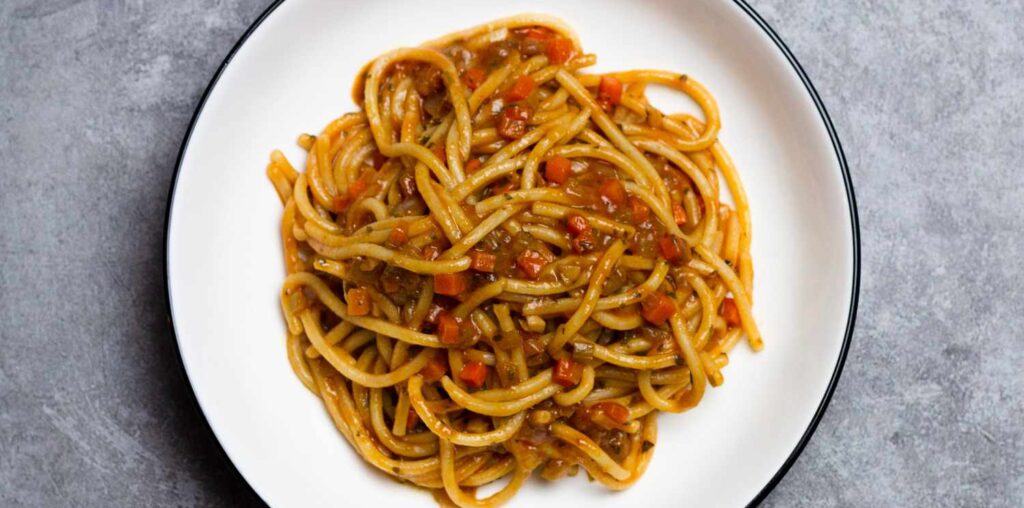Why It Works
- A garlic and herb battuto gives this meatless dish plenty of savory depth.
- Taking time to cut the vegetables by hand into a consistent small dice ensures that they maintain their form and achieve the perfect texture, standing in as the “meat” in this vegetable ragù.
- Giving the onions a head start in a covered pot ensures that they will cook thoroughly and become soft and sweet.
- Stirring high quality olive oil into the sauce right before serving gives the the pasta a rich, peppery finish.
Sugo finto, or “fake sauce,” is a meatless Tuscan ragù rooted in the tradition of cucina povera, the “poor” peasant cooking of Central and Southern Italy. Also known as sugo scappato, or “escaped sauce,” which refers to the pricey meat that has escaped the pot, sugo finto relies on a vegetable soffritto to stand in for ground beef, and turns to Tuscan staples like fresh woodsy herbs, garlic, and red wine to add layers of flavor to what is essentially a hearty tomato sauce.
Suitable Pasta Shapes
Sugo finto is traditionally served over a thick, hand–rolled pasta called pici, which look like thick, rustic spaghetti. For this recipe, since it was unrealistic to ask people to roll individual noodles by hand, I set out to find an acceptable dried pasta alternative to pici. After testing different dried options, I found that dried spaghetti alla chitarra make a decent substitute*, thanks to the pasta’s thick profile and substantial chew. Bucatini or spaghettoni also work in a pinch.
*I’m still going to make my own pici for sugo finto at my house because they’re just really fun to make. Have you ever watched a Tuscan nonna hand-roll these noodles? If not, get on that ASAP.
Perfecting the Base
There’s a pretty standard formula for making sugo finto: soffritto + herbs + garlic + wine + tomato. Somehow, even with this straightforward map, I ended up running into a few issues. The first time I made it, I tried to bypass the age-old battuto technique**—using a mezzaluna to rock back and forth over a pile of chopped onions, carrots, and celery to make a finely minced soffritto base—by using my food processor, only to discover that hand-mincing has its textural benefits.
**Battuto is the term for the raw mixture of minced vegetables (usually onion, carrot, and celery) that will become soffritto when cooked. Like batter becoming cake.
The food processor puréed the onions into a watery and sulfurous pulp; the carrot and celery pieces were chopped so unevenly that some melted away in the sauce while larger chunks remained crunchy in the finished dish. I quickly returned to my trusty cutting board and chef’s knife (since I don’t own a mezzaluna). Spending a few minutes dicing the vegetables by hand is time well-spent; after all, they’re the “meat” of the sauce.
I wanted this sauce to take all the time it needed on the stovetop, but while some meat ragus spend the better portion of a day lazily simmering away, the texture of the vegetables actually suffered if they were cooked too long; they melted right into the tomato sauce, and the texture they should provide as a substitute for meat disappeared. So simmer sugo finto just until the vegetables soften completely, but then stop.
For the tomatoes in this sugo, I turned to one of our favorite ingredients for sauces—tomato passata—that lends the sugo finto brightness and a velvety, noodle–coating texture.
Timing the Herbs for Maximum Effect
I now had a pretty good tomato sauce, but it didn’t taste particularly Tuscan; the rosemary, sage, and parsley weren’t shining through. Throughout testing I had been adding the fresh herbs to the sauce in stages: cooking sage with garlic cloves at the beginning of the process, tossing in a sprig of rosemary when adding the passata, and finishing the dish with chopped parsley at the end.
This follows the generally accepted cooking conventions: woodsy herbs stand up to longer cooking, while tender, leafy ones are used for garnishing so as not to lose their milder aroma. I decided to ditch that approach and make a garlic–herb battuto, mincing all of the herbs with garlic cloves to form a coarse paste that gets added to the soffritto before the tomatoes go into the pot. Cooking this paste of herbs and garlic gave the sauce the deep aromatic punch it was missing before.
Adding a Little Richness
With the sauce squared away, and the pasta shape chosen, it seemed that all was resolved. But when I prepared a final side-by-side test, dressing dried pasta and homemade pici with sugo finto, I was still disappointed in the final flavor of the dried pasta version, which was missing some of the richness from the olive oil in the pici dough (some recipes, like the one in the Pasta Grannies video linked above, use egg instead of oil). Finishing the sugo finto with a drizzle of olive oil when tossing with the cooked dried pasta gave the dish the grassy and peppery flavor it was missing, adding just the right amount of richness to the poor, fake sauce.

